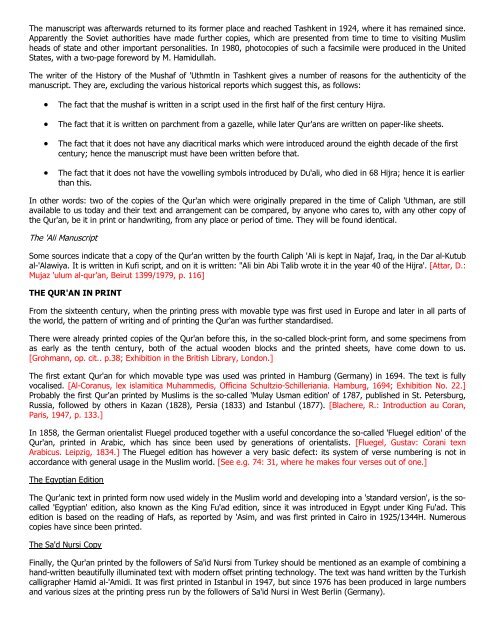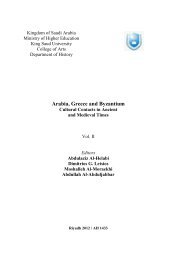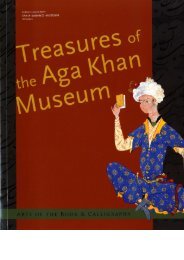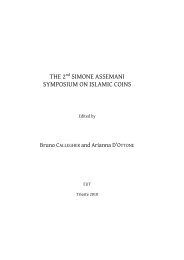ulum-al-quran
ulum-al-quran
ulum-al-quran
You also want an ePaper? Increase the reach of your titles
YUMPU automatically turns print PDFs into web optimized ePapers that Google loves.
The manuscript was afterwards returned to its former place and reached Tashkent in 1924, where it has remained since.<br />
Apparently the Soviet authorities have made further copies, which are presented from time to time to visiting Muslim<br />
heads of state and other important person<strong>al</strong>ities. In 1980, photocopies of such a facsimile were produced in the United<br />
States, with a two-page foreword by M. Hamidullah.<br />
The writer of the History of the Mushaf of 'Uthmtln in Tashkent gives a number of reasons for the authenticity of the<br />
manuscript. They are, excluding the various historic<strong>al</strong> reports which suggest this, as follows:<br />
<br />
<br />
<br />
<br />
The fact that the mushaf is written in a script used in the first h<strong>al</strong>f of the first century Hijra.<br />
The fact that it is written on parchment from a gazelle, while later Qur'ans are written on paper-like sheets.<br />
The fact that it does not have any diacritic<strong>al</strong> marks which were introduced around the eighth decade of the first<br />
century; hence the manuscript must have been written before that.<br />
The fact that it does not have the vowelling symbols introduced by Du'<strong>al</strong>i, who died in 68 Hijra; hence it is earlier<br />
than this.<br />
In other words: two of the copies of the Qur'an which were origin<strong>al</strong>ly prepared in the time of C<strong>al</strong>iph 'Uthman, are still<br />
available to us today and their text and arrangement can be compared, by anyone who cares to, with any other copy of<br />
the Qur'an, be it in print or handwriting, from any place or period of time. They will be found identic<strong>al</strong>.<br />
The 'Ali Manuscript<br />
Some sources indicate that a copy of the Qur'an written by the fourth C<strong>al</strong>iph 'Ali is kept in Najaf, Iraq, in the Dar <strong>al</strong>-Kutub<br />
<strong>al</strong>-'Alawiya. It is written in Kufi script, and on it is written: "Ali bin Abi T<strong>al</strong>ib wrote it in the year 40 of the Hijra'. [Attar, D.:<br />
Mujaz '<strong>ulum</strong> <strong>al</strong>-qur'an, Beirut 1399/1979, p. 116]<br />
THE QUR'AN IN PRINT<br />
From the sixteenth century, when the printing press with movable type was first used in Europe and later in <strong>al</strong>l parts of<br />
the world, the pattern of writing and of printing the Qur'an was further standardised.<br />
There were <strong>al</strong>ready printed copies of the Qur'an before this, in the so-c<strong>al</strong>led block-print form, and some specimens from<br />
as early as the tenth century, both of the actu<strong>al</strong> wooden blocks and the printed sheets, have come down to us.<br />
[Grohmann, op. cit.. p.38; Exhibition in the British Library, London.]<br />
The first extant Qur'an for which movable type was used was printed in Hamburg (Germany) in 1694. The text is fully<br />
voc<strong>al</strong>ised. [Al-Coranus, lex islamitica Muhammedis, Officina Schultzio-Schilleriania. Hamburg, 1694; Exhibition No. 22.]<br />
Probably the first Qur'an printed by Muslims is the so-c<strong>al</strong>led 'Mulay Usman edition' of 1787, published in St. Petersburg,<br />
Russia, followed by others in Kazan (1828), Persia (1833) and Istanbul (1877). [Blachere, R.: Introduction au Coran,<br />
Paris, 1947, p. 133.]<br />
In 1858, the German orient<strong>al</strong>ist Fluegel produced together with a useful concordance the so-c<strong>al</strong>led 'Fluegel edition' of the<br />
Qur'an, printed in Arabic, which has since been used by generations of orient<strong>al</strong>ists. [Fluegel, Gustav: Corani texn<br />
Arabicus. Leipzig, 1834.] The Fluegel edition has however a very basic defect: its system of verse numbering is not in<br />
accordance with gener<strong>al</strong> usage in the Muslim world. [See e.g. 74: 31, where he makes four verses out of one.]<br />
The Egyptian Edition<br />
The Qur'anic text in printed form now used widely in the Muslim world and developing into a 'standard version', is the soc<strong>al</strong>led<br />
'Egyptian' edition, <strong>al</strong>so known as the King Fu'ad edition, since it was introduced in Egypt under King Fu'ad. This<br />
edition is based on the reading of Hafs, as reported by 'Asim, and was first printed in Cairo in 1925/1344H. Numerous<br />
copies have since been printed.<br />
The Sa'd Nursi Copy<br />
Fin<strong>al</strong>ly, the Qur'an printed by the followers of Sa'id Nursi from Turkey should be mentioned as an example of combining a<br />
hand-written beautifully illuminated text with modern offset printing technology. The text was hand written by the Turkish<br />
c<strong>al</strong>ligrapher Hamid <strong>al</strong>-'Amidi. It was first printed in Istanbul in 1947, but since 1976 has been produced in large numbers<br />
and various sizes at the printing press run by the followers of Sa'id Nursi in West Berlin (Germany).





